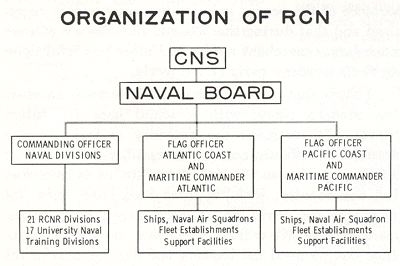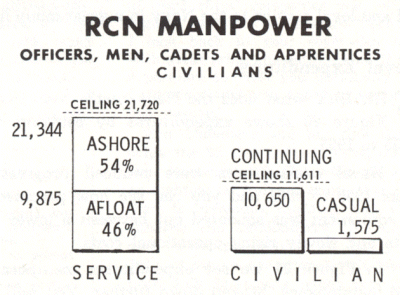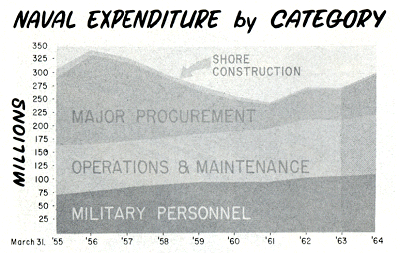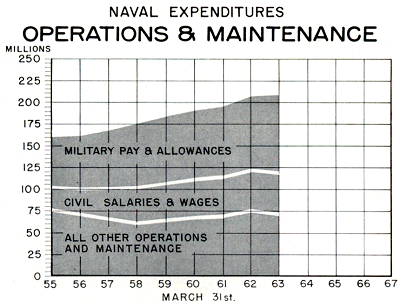The
1960s
The State of the RCN in 1963
Part 9: Organization and Budget
Presentation given to the House of Commons on July 9th, 1963 by Vide-Admiral H.S. Rayner, Chief of Naval Staff.
|
|
|
|
|
Organization
I WOULD like to show you very briefly the basic organization of the RCN (Figure 18).

Approximately 2/3 of the RCN is serving on the Atlantic Coast and 1/3 in the Pacific.
The two most important parts of the Navy are the ships including aircraft and the personnel of the Navy.

Today, the authorized strength of the Navy is 21,720. Against this are borne 21,344 officers and men (Figure 19). 01 these some 46 per cent are serving at sea and the balance ashore. The great majority of those who are employed ashore are either instructors or are under instruction in the Fleet Schools. The remainder are employed in billets suitable to their trades, thus permitting a necessary measure of rotation between sea and shore duty.
I would like to emphasize again the importance of the training task facing a modern-day Navy. As equipments become more and more sophisticated, the need for higher degrees of maintenance and operating skills increases. These needs must be met by continuous and progressive effort by ships and schools. This challenge is being met in a most heartening manner by all concerned.
It has long been the policy of the Navy to employ civilians to the greatest possible extent in shore establishments and support activities. At the present time 11,611 civilians are so employed, and provide most useful and loyal service to the Navy in a great many fields.
Naval Expenditures
FINALLY what does the Navy cost?
Figure 20 shows expenditures by category from 1955 to 1963.

Naval expenditures were reduced progressively from 1956 to 1961 and you can see how procurement of equipment was squeezed out between a lower total vote and slowly rising operational costs.
In
Figure 21 we see expenditures on operations and maintenance, broken
down further. You will note that maintenance costs since 1955 have
remained much the same, despite increased wages and material costs.
Also, the number of ships in commission has increased during this
period.

The Navy is constantly looking for extra yardage from defence dollars because, as in so many other enterprises, costs are rising. The wonderful new equipment which is becoming available is much more effective, but it is also much more costly
>>> Go to Next Page
